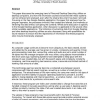Free Online Productivity Tools
i2Speak
i2Symbol
i2OCR
iTex2Img
iWeb2Print
iWeb2Shot
i2Type
iPdf2Split
iPdf2Merge
i2Bopomofo
i2Arabic
i2Style
i2Image
i2PDF
iLatex2Rtf
Sci2ools
91
Voted
IJDE
2006
2006
Google Desktop as a Source of Digital Evidence
This paper discusses the emerging trend of Personal Desktop Searching utilities on desktop computers, and how the information cached and stored with these systems can be retrieved and analysed, even after the original document has been removed. Focusing on the free Google Desktop application, this paper first analyses how the program operates, the processes involved, files created and altered, and methods on retrieving this data without corrupting the contents. Whilst some discussion is specific to the Google Desktop application, other discussion is applicable to the several other, similar available applications. The limitations of extracting data from Google Desktop and other desktop searching utilities are also discussed, along with possibilities for future research to ensure that the repositories of information that these programs store may be forensically analysed.
| Added | 12 Dec 2010 |
| Updated | 12 Dec 2010 |
| Type | Journal |
| Year | 2006 |
| Where | IJDE |
| Authors | Benjamin Turnbull, Barry Blundell, Jill Slay |
Comments (0)

